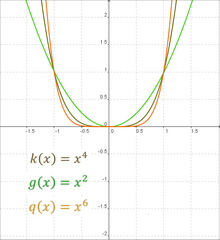Power function
In mathematics, a power function is a function of the form where is constant and is a variable.[1] In general, can belong to one of several classes of numbers, such as the positive and negative integers.[2] They are a fundamental concept in algebra and pre-calculus, leading up to the formation of polynomials.[3] Their general form is , where is also a constant.
Trivial cases

When , is the constant function for all real . Graphically, it is a horizontal line at , and can be thought of as the function that maps all inputs to 0, the number zero.
When , is the constant function for all real . Graphically, it is a horizontal line at , and can be thought of similarly to the previous case; it simply maps all inputs to 1, the number one.
When , is the identity function . Graphically, it is a line through the origin with slope 1, and can be thought of as the function that maps every input to itself.
Integer cases where

When is in and , two primary families exist: when is even, and when is odd. In general, when is even and is large, will tend towards positive infinity if , and toward negative infinity if . All even power function graphs of this family have the general shape of , flattening more in the middle as increases.[4] Functions with this kind of symmetry are called even functions.
When is odd, 's asymptotic behavior reverses from positive to negative . For , and large and positive , will tend towards positive infinity, while for large and negative , will tend towards negative infinity. For , the opposite is true in each case. All odd power function graphs of this family have the general shape of , flattening more in the middle as increases.[5] Functions with this kind of symmetry are called odd functions.
Integer cases where
When is in and , takes the shape of a hyperbola. As with positive integers, there exist two primary families according to 's parity. Regardless of said parity, however, these families all tend toward zero for large , whether positive or negative.[6] Where their behavior differs is in approaching from the right and left.
When is even, is even, and thus symmetric about the -axis.[7] Thus, when approaching from either the right or the left, will tend towards positive infinity when is positive, and negative infinity when is negative.
When is odd, is odd, and thus symmetric about the origin.[8]
Generalizations
Polynomials, another fundamental algebraic construct, can be seen as being created from multiple power functions and their coefficient terms (i.e. ), added together.[9] For example, or .
Power functions are a special case of power law relationships, which appear throughout mathematics and statistics.
See also
References
- ↑ Anton, Howard; Bivens, Irl; Davis, Stephen. Calculus: Early Transcendentals (9th ed.). John Wiley & Sons. p. 28.
- ↑ Anton, Howard; Bivens, Irl; Davis, Stephen. Calculus: Early Transcendentals (9th ed.). John Wiley & Sons. pp. 28–29.
- ↑ Anton, Howard; Bivens, Irl; Davis, Stephen. Calculus: Early Transcendentals (9th ed.). John Wiley & Sons. p. 30.
- ↑ Anton, Howard; Bivens, Irl; Davis, Stephen. Calculus: Early Transcendentals (9th ed.). John Wiley & Sons. p. 28.
- ↑ Anton, Howard; Bivens, Irl; Davis, Stephen. Calculus: Early Transcendentals (9th ed.). John Wiley & Sons. p. 28.
- ↑ Anton, Howard; Bivens, Irl; Davis, Stephen. Calculus: Early Transcendentals (9th ed.). John Wiley & Sons. p. 29.
- ↑ Anton, Howard; Bivens, Irl; Davis, Stephen. Calculus: Early Transcendentals (9th ed.). John Wiley & Sons. p. 29.
- ↑ Anton, Howard; Bivens, Irl; Davis, Stephen. Calculus: Early Transcendentals (9th ed.). John Wiley & Sons. p. 29.
- ↑ Anton, Howard; Bivens, Irl; Davis, Stephen. Calculus: Early Transcendentals (9th ed.). John Wiley & Sons. p. 31.
